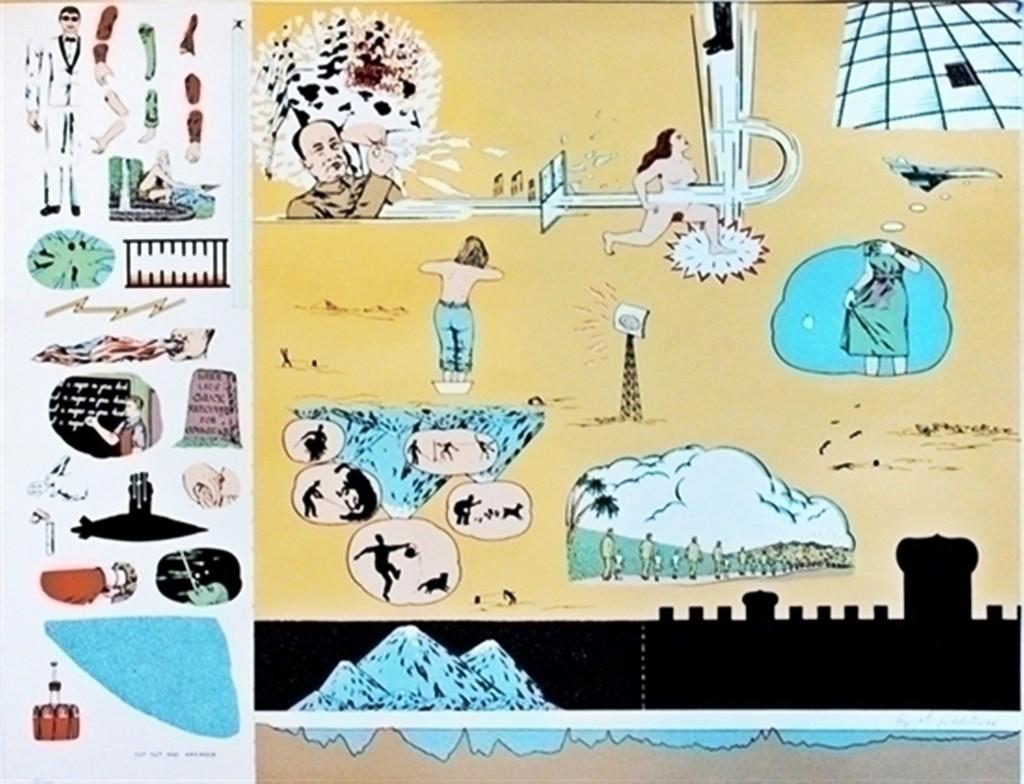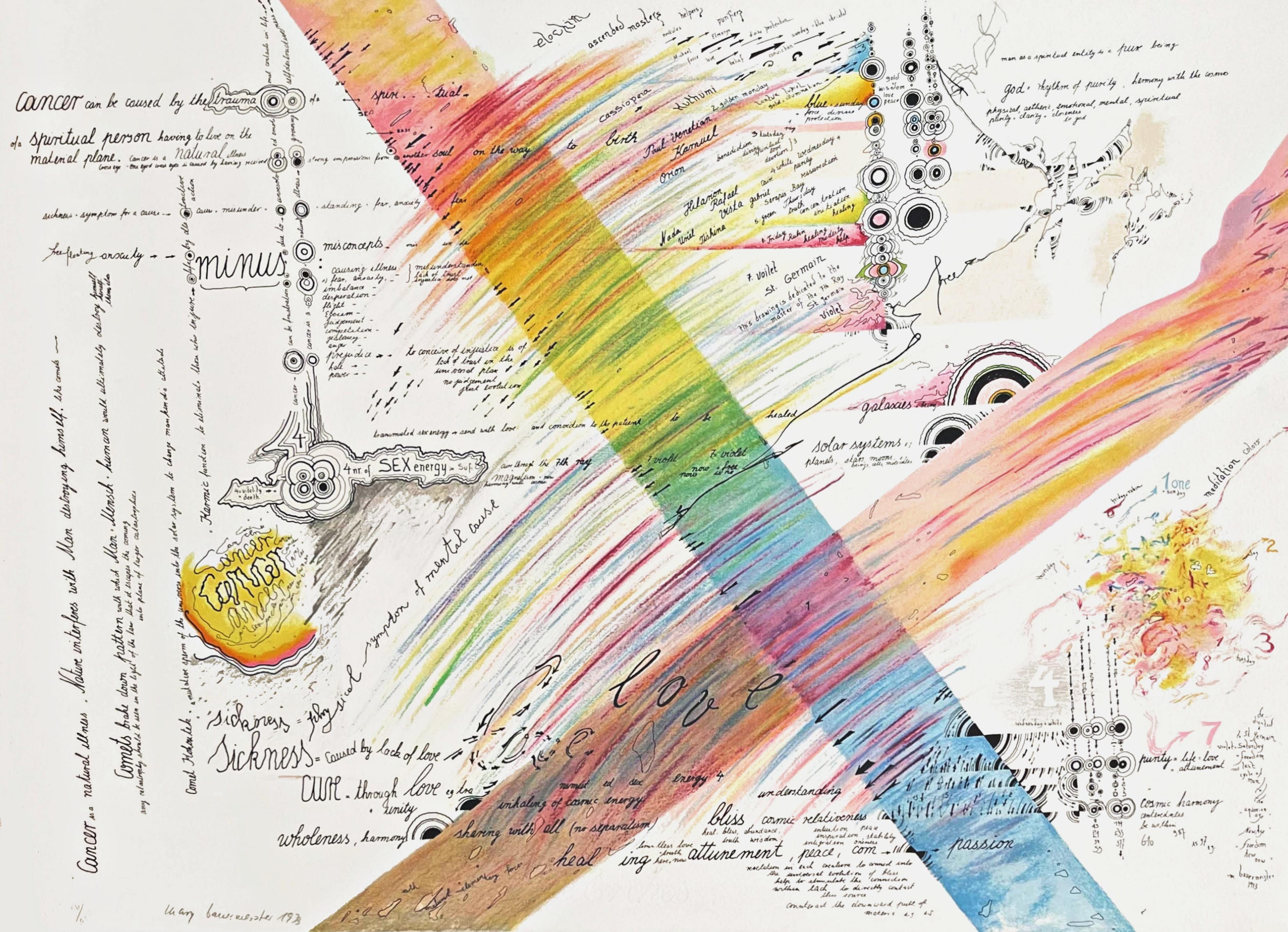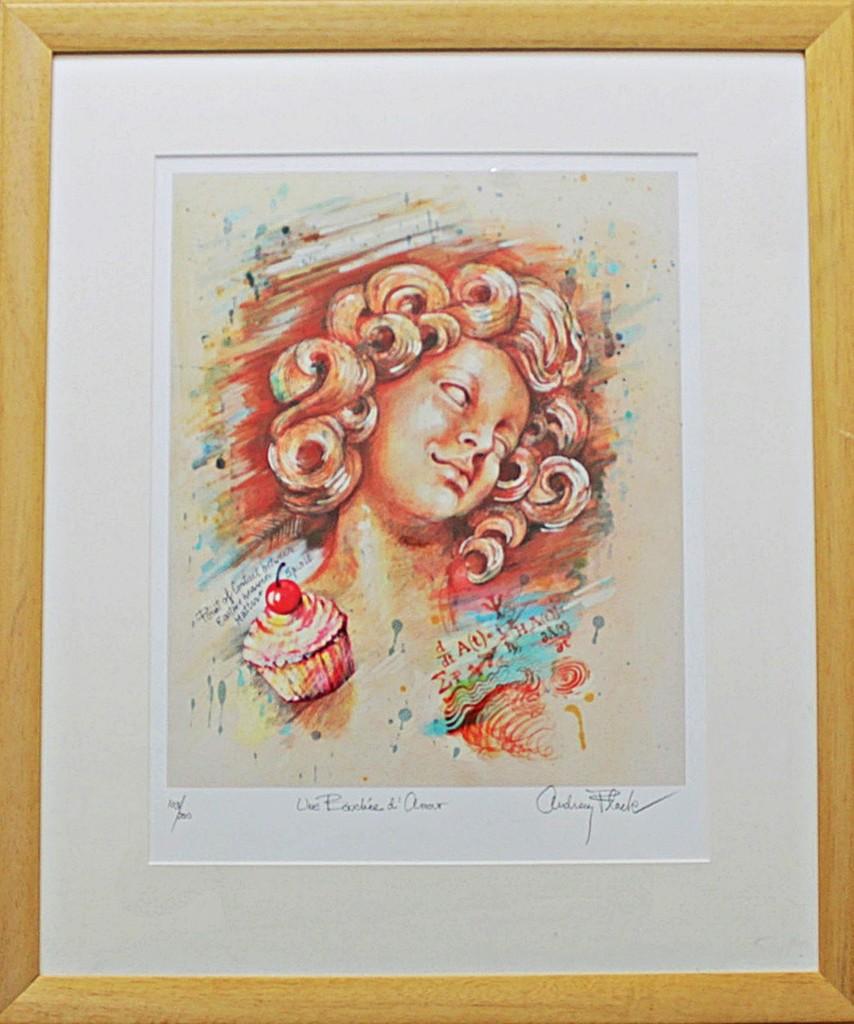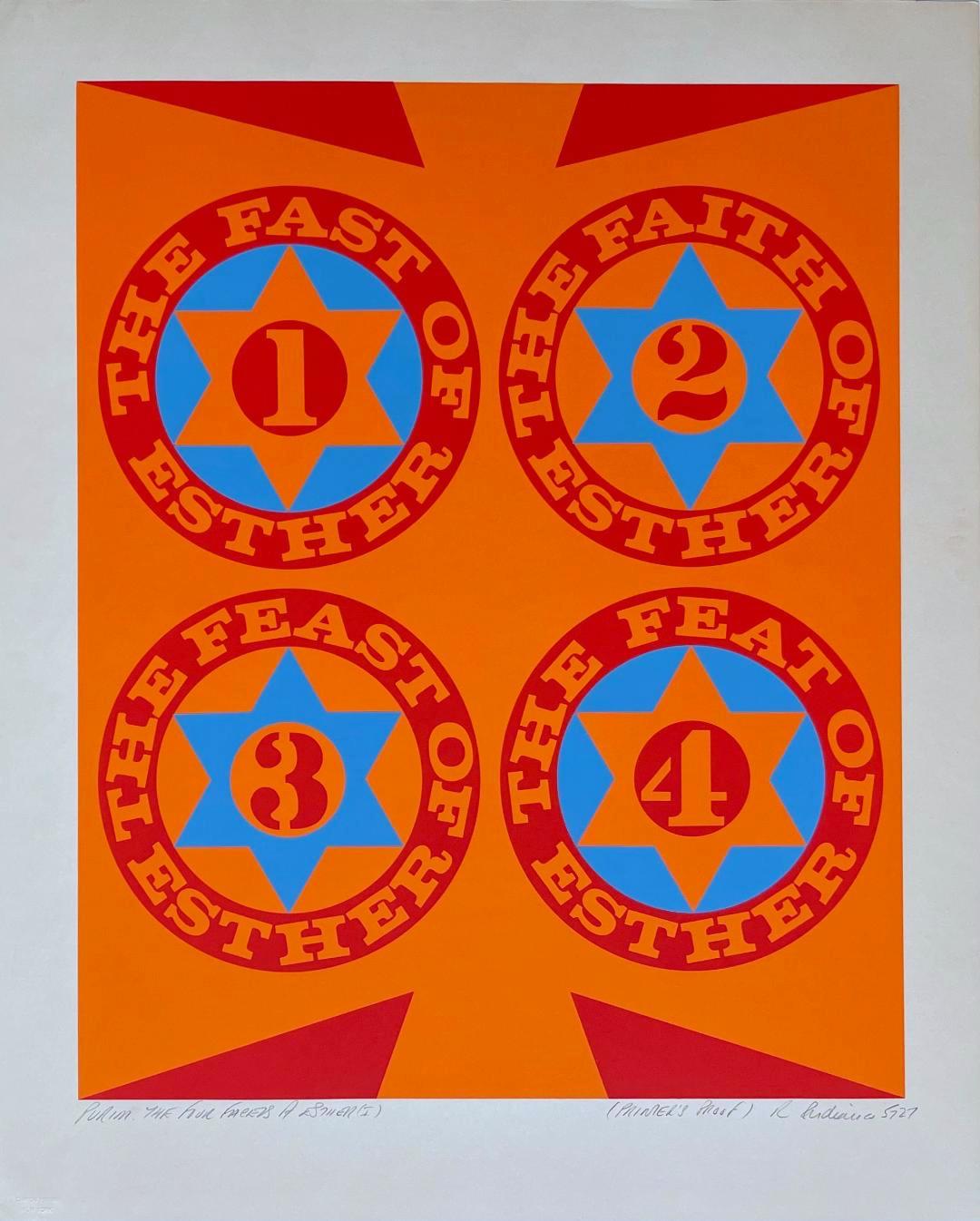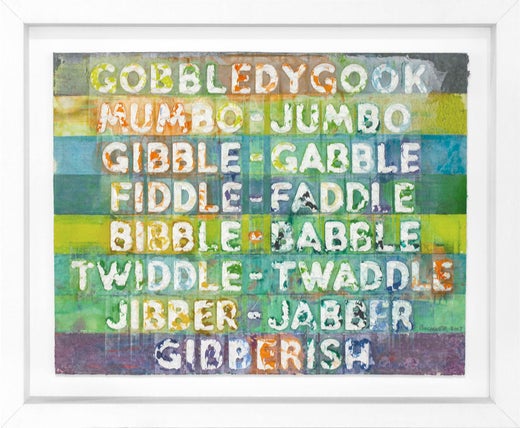Mel BochnerKick Against the Pricks, Conceptual, Pop, Protest, Text Art, Signed/N - Framed 2018
2018
About the Item
- Creator:Mel Bochner (1940, American)
- Creation Year:2018
- Dimensions:Height: 12.5 in (31.75 cm)Width: 30 in (76.2 cm)Depth: 0.5 in (1.27 cm)
- Medium:
- Movement & Style:
- Period:
- Condition:Artwork ships framed.
- Gallery Location:New York, NY
- Reference Number:1stDibs: LU174529895452
Mel Bochner
Mel Bochner experimented with a range of styles before finding his eventual success as a pioneer in Conceptual art. An audacious 1966 show at School of Visual Arts (SVA) in Manhattan that he presented, “Working Drawings and Other Visible Things on Paper Not Necessarily Meant to Be Viewed as Art,” remains a seminal touchstone for Conceptualism.
Bochner was born to a Pittsburgh sign painter in 1940. While attending the Carnegie Institute of Technology (now Carnegie Mellon) in the late 1950s, he studied color theory and modernist movements as well as classical drawing, a balance that was formative in his career. After graduation, he moved to San Francisco, creating paintings influenced by Clyfford Still and Jean Dubuffet.
It wasn’t until Bochner “found his way out of the labyrinth of late Abstract Expressionism,” as he put it to The Brooklyn Rail, that he began to create his most meaningful work. Following a stint auditing philosophy classes after a friend introduced him to the work of Heidegger, Bochner relocated to New York, finding work as a guard at the Jewish Museum. In Manhattan, he ran in the same circles as Dan Flavin, Brice Marden and Donald Judd.
“One of the conversations going on in New York in the late ’60s was about the relationship of the object to the art experience,” Bochner said. “...Younger artists like myself were talking about what it would mean to eliminate the object altogether.” This idea would become the foundation of the Conceptual movement, in which Bochner was instrumental. The artist is probably best known for his text-focused paintings, including a series that plays with the phrase “Blah Blah Blah.” He produces work that regards art as an experience, rather than an object, centering on the process of creation and viewership as opposed to the finished product.
Bochner’s “Working Drawings and Other Visible Things on Paper Not Necessarily Meant to Be Viewed as Art” featured drawings, notes and outlines from the likes of Milton Glaser, Carl Andre, Sol LeWitt and others as well as pages from Scientific American. Bochner, then an art history professor at SVA, photocopied the assemblage of works, added them to binders and positioned them on pedestals for the exhibition because the show’s organizers lacked the funds to frame the pieces.
Bochner’s works can be found in the collections of many major museums, including the Museum of Modern Art, the Metropolitan Museum of Art and the Whitney Museum of American Art.
Find original Mel Bochner prints and other art on 1stDibs.
- ShippingRetrieving quote...Ships From: New York, NY
- Return PolicyA return for this item may be initiated within 1 day of delivery.
- "If Elections Were Held Today" from the Castelli Sonnabend CollectionLocated in New York, NYHans Haacke "If Elections Were Held Today" from the Castelli Sonnabend Collection, 1973 Silkscreen in portfolio sleeve of Crane's bond paper No. 1. Stamped and numbered. Unframed in ...Category
1970s Conceptual Abstract Prints
MaterialsScreen
- Eddie (Sylvie's Brother) in the Desert (celebrated 1960s silkscreen)By Oyvind FahlstromLocated in New York, NYÖyvind Fahlström Eddie (Sylvie's Brother) in the Desert (from New York International Portfolio), 1966 Silkscreen on wove paper Pencil signed and numbered from the limited edition of ...Category
1960s Conceptual Abstract Prints
MaterialsScreen
- Rainbow Signed 1970s silkscreen & lithograph by pioneering female Fluxus artistBy Mary BauermeisterLocated in New York, NYMary Bauermeister Rainbow, 1973 Lithograph and silkscreen on creamy white paper Hand signed, dated and numbered 56/250 by the artist on the front 19 x 25.5 inches Unframed This work is on the permanent collection of various institutions like: Rice University, Samuel Dorksy Museum of Art, Rutgers Zimmerli Museum and Wheaton College Massachusetts. While studying the fringe sciences the 1970s, Bauermeister created Rainbow (1973), a lithograph and silkscreen. She uses a creamy white background as the base. Two intersecting diagonal bands of color transcend across the page, and black cursive lettering dances over the surface serving as a mind map of interweaving ideas. Through the central band, Bauermeister shifts through the color spectrum; she begins with red and finishes with violet. Inspired by music, she uses strokes of color that are rhythmically smeared across the lithograph. The surface lettering, a kind of visual poetry, explores her interest in human emotion and science. The viewer can see Bauermeister’s thoughts as they flow into one another through the use of words such as bliss, love, and healing. Bauermeister also includes a repetition of words such as cancer, sickness, and cure. The word cancer emerges from a cell-like shape. A careful study of the words shows that they may seem dark in nature; however, she juxtaposes these words against the cheerful title and colors. Perhaps the rainbow symbolizes a new hope, an inspiration for an optimistic future. -Courtesy to the Samuel Dorsky Museum of Art About Mary Bauermeister: A multidisciplinary artist known for her intricate and enigmatic assemblages, Mary Bauermeister (1934-2023) continues to defy categorization with layered works in a range of media. A precursory figure of the Fluxus movement—her studio was the meeting point for a number of defining artists of the avant-garde—her work plays an integral role in the discussion of art, both European and American, that emerged from the 1960s. Her reliefs and sculptures, which have incorporated drawing, text, found objects, natural materials and fabric, reference a plethora of concepts: from natural phenomena and astronomy to mathematics and language, as well as her own “spiritual-metaphysical experiences.” Maturing amidst the currents of Minimalism and Pop Art, Bauermeister’s art has resisted labels due to the singular expression of her interests and concerns, among them the simultaneous transience and permanence of the natural world with experimentations in transparency and magnification, multiplication and variation, structure and order, chance and ephemerality, introversion and extroversion. Her three-dimensional receptacles of thoughts, ideas, and notes contain visual, conceptual, and philosophical paradoxes that challenge perceptions and that offer literal and metaphorical windows into which one can glimpse the inner workings of the artist’s mind. - Courtesy of Michael Rosenfeld...Category
1970s Modern Abstract Prints
MaterialsLithograph, Screen, Mixed Media, Pencil, Graphite
- Santa Fe Opera (Deluxe VIP Edition; Hand Signed & Numbered AP Edition of 50)By Robert IndianaLocated in New York, NYROBERT INDIANA Santa Fe Opera (Hand signed, numbered), 1976 Silkscreen on wove paper 37 1/2 × 27 inches Edition AP 7/50 Hand Signed and dated lower rig...Category
1970s Pop Art Abstract Prints
MaterialsScreen, Pencil, Graphite
- Une Bouchee D'Amour (signed presentation print by female photorealist artist)By Audrey FlackLocated in New York, NYAudrey Flack Une Bouchee D'Amour, 2013 Mixed media: Digitized drawing with silkscreen Signed, titled and numbered recto (front) in graphite pencil Annotated presentation proof Frame included: in elegant vintage wood frame Print Club of New York, Publisher; Printer: Experimental Printmaking Institute, Lafayette College, Easton, PA Digitized drawing with silkscreen Flack's "Une Bouchee d'Amour" was the 2013 presentation print commissioned by The Print Club of New York, and it is accompanied by a COA issued by the Print Club of NY as well as Alpha 137...Category
2010s Photorealist Abstract Prints
MaterialsMixed Media, Digital, Screen, Pencil, Graphite
- Purim: The Four Facets of Esther (I) Sheehan, 36, Rare signed Printers Proof '66By Robert IndianaLocated in New York, NYRobert Indiana Purim: The Four Facets of Esther (I) Sheehan, 36, 1966 Color silkscreen on off white wove paper Printed by Stephen Poleskie, Chiron Press, New York. Published by The J...Category
1960s Abstract Geometric Abstract Prints
MaterialsScreen, Pencil, Graphite
- Geometric Woman's Portrait - Rare Signed Graphite Drawing on Paper 1962Located in Soquel, CAGeometric Woman's Portrait - Rare Signed Graphite Drawing on Paper 1962 Beautiful, soft original drawing by Eugene Hawkins (American, b. 1933). A realistic depiction of a short-haired woman, her large lips parted into a soft smile. She's surrounded in geometric shapes offering a wonderful juxtaposition to the natural curves of her face and hair. Signed in pencil, "Eugene Hawkins '62" Presented in a new black mat. Mat size: 20"H x 16"W Paper size: 18.5"H x 14.5"W Eugene Hawkins (American, b. 1933) is a BIPOC artist known for his detailed portraiture and printmaking. He is listed in Who Was Who in American Art, 1564-1975, and his work was exhibited in the Whitney Museum of American Art. He spent the majority of his life working and exhibiting in Southern California. His work frequently touches upon socio-political subjects, making strong statements about the world. The California African American Museum features Eugene Hawkins's work in the Permanent Collection. Exhibition: 2017 Paperworks: Selections from the Permanent Collection focuses on works on paper produced from 1950-2000 and includes figurative, impressionistic, and abstract styles. The exhibition showcases the radically diverse range of works on paper created by African American and other artists over the last two centuries, and includes drawings, prints, paintings, and collages by Edward Mitchell Bannister...Category
1960s American Modern Figurative Prints
MaterialsGraphite, Paper
- Passeggiata RomanaBy Massimo Campigli, 1895-1971Located in New York, NYA very good impression of this color lithograph. Artist's proof, aside from the edition of 175. Signed, dated and inscribed "Epreuve d'artiste" in pencil. Printed by Desjobert, Paris...Category
1950s Futurist Abstract Prints
MaterialsColor Pencil, Lithograph
- Pleased to Meet You AgainLocated in North Adams, MASilkscreen in 9 colors on 320 gram Coventry Rag Dimensions: 29" x 29" Signed by the Artists in pencil An edition of 75 John “CRASH” Matos and Eric Orr met for the first time as high school students. Although the exact location is unclear, both agree that it would have been at either Fashion Moda or the Writers’ Bench at 149th Street and Grand Concourse. Founded by Stefan Eins in 1978, Fashion Moda began as a “cultural concept” whose principles revolved around the fact that art can be made by anyone, anywhere and art should be accessible to anyone, anywhere. Located in the South Bronx, Fashion Moda embraced new talent and encouraged creative production across all mediums. The gallery has been credited as a major force behind the recognition of graffiti writing as an art form and it played a pivotal role in a community where Hip Hop was rapidly emerging. CRASH was only 19 years old when he curated “Graffiti Art Success for America” at Fashion Moda and his varied experiences at the gallery would later inspire his founding of WALLWORKS. The 149th Street Writers’ Bench, located at the back of the uptown...Category
21st Century and Contemporary Street Art Figurative Prints
MaterialsScreen
- RepeatLocated in North Adams, MAIn 1984, Eric Orr and Keith Haring joined forces to create a series of chalk drawings in the NYC subways. As their work evolved, the artists shifted their focus from the subway to the studio and embarked on the production of a suite of drawings. Included in the group was Repeat which had made its first appearance in the 23rd Street IRT uptown station. Little did Orr and Haring know that the reimagined drawing would be auctioned at Christie’s six years later. 2020 heralds a new beginning for Repeat, a truly unique silkscreen print that both illustrates and celebrates a fierce friendship that began in the early 1980s at The Roxy roller rink in NYC, when two young artists decided to trade t-shirts on the dance floor. Repeat, Eric Orr and Keith Haring, 2020 Silkscreen on 320 gram Coventry Rag paper with hand-deckled edges Dimensions: 20 x 28 inches Edition Size: 250 with 25 Artist Proofs and 25 Printer Proofs Signed and numbered in pencil by Eric Orr Plate signed by Eric Orr and Keith Haring Courtesy of Eric Orr and the Keith Haring Foundation Printed and Published by Gary Lichtenstein...Category
1980s Street Art Figurative Prints
MaterialsScreen
- GelsominaLocated in London, GBSigned and numbered 20/20 Silkscreen print on Somerset enhanced velvet fine art paper 330 gsm 29.7 x 42 cm Framed (matte black wooden frame, black mount, UV anti-reflective museum ...Category
2010s Expressionist Abstract Prints
MaterialsScreen
- Waving the flagLocated in Llanbrynmair, GB’Waving the Flag’ By Kip Gresham Medium - Screen Print Edition - 21/24 Signed - Yes Size - 515mm x 645mm Date - 1986 Condition - Very good. 8 out of 10. Col...Category
1980s Abstract Abstract Prints
MaterialsScreen
Recently Viewed
View AllRead More
Conceptual Artist Mel Bochner Explores His Connections to 20th-Century Italian Art
The American artist organized an exhibition of his works together with those of postwar Italian talents Alighiero Boetti and Lucio Fontana at the Hudson Valley’s Magazzino Italian Art space.
Welcome (Back) to the Wild, Wonderful World of Walasse Ting
Americans are rediscovering the globe-trotting painter and poet, who was connected to all sorts of art movements across a long and varied career.

